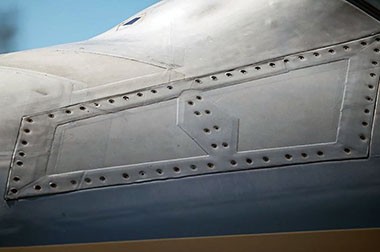2024-T351 Aluminum vs. 2124 Aluminum
2024-T351 and 2124 aluminum alloys are both high-strength aluminum alloys, primarily used in aerospace and other demanding applications. However, their compositions, properties, and typical uses differ.
2124 aluminum is typically a better choice for applications requiring higher strength and better fracture toughness, while 2024-T351 aluminum remains a popular choice for strength in aerospace structures, although it may require additional treatment to improve corrosion resistance.
| Property | 2024-T351 Aluminum | 2124 Aluminum |
| Strength | Slightly lower tensile and yield strength | Slightly higher tensile and yield strength |
| Corrosion Resistance | Lower corrosion resistance, requires coatings | Better corrosion resistance due to molybdenum |
| Fracture Toughness | Moderate fracture toughness | Superior fracture toughness, especially under high stress |
| Applications | Used for high-strength aerospace components, where corrosion can be managed | Preferred for applications requiring higher stress resistance and better fracture toughness, especially in aerospace |
2024-T351 Aluminum Alloy
- Strength: 2024-T351 is known for its high strength and excellent fatigue resistance. It has good machinability and is typically used in applications requiring a high strength-to-weight ratio.
- Heat Treatment: T351 temper indicates the alloy has been solution heat treated and artificially aged. This process enhances its mechanical properties.
- Corrosion Resistance: Compared to some other aluminum alloys, its corrosion resistance is generally lower, especially when exposed to harsh environments. It is typically anodized or coated to improve corrosion resistance.
- Applications: Commonly used in aerospace structures, aircraft components, and military applications. It is often used for wing skins and fuselage structures.
2124 Aluminum Alloy
- Strength: 2124 also exhibits high strength and excellent fatigue resistance, similar to 2024, but its mechanical properties may vary slightly depending on specific tempering and processing.
- Heat Treatment: It can be heat treated to improve its mechanical properties, although the specific heat treatment process may differ from 2024.
- Corrosion Resistance: Compared to 2024, its corrosion resistance is generally lower. Like 2024, it is typically anodized or coated to achieve better performance in corrosive environments.
- Applications: Commonly used in aerospace applications, particularly where high strength is required, such as in structural components and military applications.
2024-T351 Aluminum vs. 2124 Aluminum Mechanical Properties
2024-T351:
Fracture Toughness: Medium.
Heat Treatment: T351 is a solution heat-treated and stretched (to relieve stress) condition.
2124 Aluminum:
Fracture Toughness: Higher than 2024, especially under stress conditions.
Heat Treatment: Similar to 2024, heat treatment improves its strength, but 2124 has better stress corrosion resistance.
| Property | 2024-T351 Aluminum | 2124 Aluminum |
| Elastic (Young's, Tensile) Modulus (x 10⁶ psi) | 10 | 10 |
| Elongation at Break (%) | 13 | 5.7 |
| Fatigue Strength (x 10³ psi) | 20 | 19 |
| Poisson's Ratio | 0.33 | 0.33 |
| Shear Modulus (x 10⁶ psi) | 3.9 | 3.9 |
| Shear Strength (x 10³ psi) | 41 | 41 |
| Tensile Strength: Ultimate (UTS) (x 10³ psi) | 67 | 71 |
| Tensile Strength: Yield (Proof) (x 10³ psi) | 47 | 62 |
2024-T351 Aluminum vs. 2124 Aluminum Alloy Composition
2024-T351:
Main Alloying Elements: Copper (Cu), Manganese (Mn), Magnesium (Mg), and a small amount of Chromium (Cr).
Copper Content: Approximately 3.8–4.9%, which gives it high strength but lower corrosion resistance.
2124 Aluminum:
Main Alloying Elements: Primarily Copper (Cu), similar to 2024, but with the addition of Molybdenum (Mo) and a small amount of Zirconium (Zr).
Copper Content: Similar to 2024, but the addition of Molybdenum helps improve strength and stress corrosion resistance.
| Element | 2024-T351 Aluminum | 2124 Aluminum |
| Aluminum (Al) | 90.7 to 94.7% | 91.3 to 94.7% |
| Chromium (Cr) | 0 to 0.1% | 0 to 0.1% |
| Copper (Cu) | 3.8 to 4.9% | 3.8 to 4.9% |
| Iron (Fe) | 0 to 0.5% | 0 to 0.3% |
| Magnesium (Mg) | 1.2 to 1.8% | 1.2 to 1.8% |
| Manganese (Mn) | 0.3 to 0.9% | 0.3 to 0.9% |
| Silicon (Si) | 0 to 0.5% | 0 to 0.2% |
| Titanium (Ti) | 0 to 0.15% | 0 to 0.15% |
| Zinc (Zn) | 0 to 0.25% | 0 to 0.25% |
| Zirconium (Zr) | 0 to 0.2% | 0% |
| Residuals | 0 | 0 to 0.15% |
2024-T351 Aluminum vs. 2124 Aluminum Corrosion Resistance
2024-T351:
Compared to other aluminum alloys, it has high strength but lower corrosion resistance, especially in humid and marine environments.
Coatings or anodizing are required to improve corrosion resistance, particularly for aerospace applications.
2124 Aluminum:
Due to the addition of Molybdenum, its corrosion resistance is better than 2024.
It is still not as corrosion-resistant as alloys like 7075, but it is better suited for high-stress corrosion environments where 2024 might not perform well.
2024-T351 Aluminum vs. 2124 Aluminum Applications
2024-T351:
Primary Uses: Widely used in aerospace applications, including aircraft fuselage, wings, and other high-stress components.
Key Advantage: High strength-to-weight ratio, especially in non-corrosive environments or where additional coatings are applied.
2124 Aluminum:
Primary Uses: Also used in aerospace, particularly for high-performance, high-stress components, including aerospace structures, rocket parts, and high-temperature areas.
Key Advantage: Better suited for harsher stress corrosion conditions and applications requiring higher fracture toughness.
2024-T351 Aluminum vs. 2124 Aluminum Thermal Properties
| Property | 2024-T351 Aluminum | 2124 Aluminum |
| Latent Heat of Fusion (J/g) | 390 | 390 |
| Maximum Temperature: Mechanical (°F) | 390 | 380 |
| Melting Completion (Liquidus) (°F) | 1180 | 1180 |
| Melting Onset (Solidus) (°F) | 930 | 930 |
| Specific Heat Capacity (BTU/lb-°F) | 0.21 | 0.21 |
| Thermal Conductivity (BTU/h-ft-°F) | 70 | 88 |
| Thermal Expansion (µm/m-K) | 23 | 23 |
2024-T351 Aluminum vs. 2124 Aluminum Electrical Properties
| Property | 2024-T351 Aluminum | 2124 Aluminum |
| Electrical Conductivity: Equal Volume (% IACS) | 30 | 38 |
| Electrical Conductivity: Equal Weight (Specific) (% IACS) | 90 | 110 |
2024-T351 Aluminum vs. 2124 Aluminum Otherwise Unclassified Properties
| Property | 2024-T351 Aluminum | 2124 Aluminum |
| Base Metal Price (% relative) | 11 | 10 |
| Density (lb/ft³) | 190 | 190 |
| Embodied Carbon (kg CO₂/kg material) | 8.3 | 8.2 |
| Embodied Energy (x 10³ BTU/lb) | 65 | 64 |
| Embodied Water (gal/lb) | 140 | 140 |









